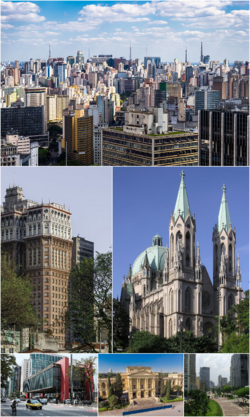Castelonovo
This article is incomplete because it is pending further input from participants, or it is a work-in-progress by one author. Please comment on this article's talk page to share your input, comments and questions. Note: To contribute to this article, you may need to seek help from the author(s) of this page. |
Castelonovo | |
|---|---|
| Município e Capital Federal de Castelonovo Municipality and Federal Capital of Castelonovo | |
 Following down left to right: financial centre; Bachelet Building; the city's cathedral; Museum of Arts of Castelonovo; Mascarenhas Palace and the Guararapes' Valley. | |
| Nickname(s): Terra de Oportunidades (Land of Opportunities); Selva de Pedra (Stone's Jungle) | |
| Motto(s): Semper invicta "Always undefeated" | |
| Country | |
| Province | Federal Capital |
| Foundation | 19 May 1544 |
| Boroughs | 16 boroughs
|
| Government | |
| • Type | Mayor-council |
| • Body | Municipal Chamber |
| • Mayor | Júlio Passos |
| • Vice Mayor | Catarina Beltrão |
| Population (2019) | |
| • Total | 3,724,976 |
| Demonym | Castelan |
| Time zone | BCT |
| Area code | CST (11) |
Castelonovo ([kɐstʃelɔnovo]), officially the Municipality and Federal Capital of Castelonovo (Lusitan: Município e Capital Federal de Castelonovo), is the capital and largest city of Belmonte. According to the last demographic census made in 2018, the general population of the city and its metropolitan area corresponds to 3,724,976 inhabitants.
Founded by bandeirantes in the 16th century, Castelonovo was located between several trade routes that transported goods to villages and markets, which made the small city become within a few years an important commercial centre to the colony. Also, the rough terrain was frequently used as a natural barrier against indigenous attacks, which was another decisive factor for the upcoming centralization and transference of various public services and institutions that were formerly situated in several coastal cities to there. Soon after the Belmontese independence, the city already was the most important of the entire country, but it only became the national capital and its own province after the establishment of the republic in 1819.
With the advent of the industrial revolution, the city had one of the largest growth rates in Belmonte, with several roads and railways being built and used to connect other major cities at the same time that thousands of farmers and former slaves came to work in the new factories. In the 20th century, Castelonovo was hit with another rural exodus and political and economical instabilities, being at the centre of protests, general strikes and battles. During the Great War, the city was invaded, bombed and occupied by Entente forces until being liberated by resistance troops in the Spring March. After the war, the city was undergone through various revitalization and modernization programs and expanded considerably.
Today, Castelonovo is one of the most important cities of the Asterias, since it is the political, administrative, financial and cultural centre of Belmonte where the majority of governmental institutions, banks, embassies, agencies and organizations are situated, with its name being used as a metonymy for the Federal Government as well. The city is also a cosmopolitan one, with several inhabitants coming from different regions and countries around the globe. Despite having one of the highest GDP and HDI of Belmonte, Castelonovo suffers from several social and urban problems such as high traffic, poverty, crime and pollution.
Etymology
The name Castelonovo comes from the junction of the words castelo and novo, which means “castle” and “new” respectively, therefore meaning a new castle. Before the arrival of colonists in the region, natives called the place as Guyraoga, “bird’s home”, name which was also used by the first bandeirantes that started to settle there in the 16th century. With the definitive foundation of the city, Castelonovo had its first name officialized as Castle of Saint Peter of Guyraoga and, after a fire years later, it has its name reduced to Castelonovo only.
History
Foundation and colonial era

Castelonovo was founded on 19 May 1544 by bandeirantes and jesuits from an expedition that started at the village of Pinheiros years before, with the group being led by the priests João Paes and Augusto Linhares, who built a church and the first buildings of the new settlement. Prior to the Lusitan arrival, the region was widely populated by Tupi tribes located next to the ground zero of the city who had maintained relatively positive relations with the settlers. Due to its rough terrain, the village was saved from various attacks from other tribes, which made possible the expansion of jesuit activities in the region such as the conversion of natives to Catholicism, however, in 1568, a big fire caused by uncertain reasons destroyed the entire village and killed the majority of its citizens.
Although being left abandoned for almost two years, the village was rebuilt thanks to jesuit efforts with a new convent as well to intensify conversion activities in the area, attracting neighbouring farmers and old dwellers. Also, yet in the 16th century, the city gained a strategical meaning since it started to be used as a base for other bandeirante expeditions, which contributed to its fast reconstruction and expansion in the following years.
At the end of the colonial period, the city drastically grew as trade routes maintained by tropeiros crossed the city, transporting goods, food and letters to other cities and villages from several captaincies. Another important factor which led to its fast growth in importance and relevance was its geographic localization at the centre of Belmonte as well as its natural defences, resulting in the transference of various institutions and public services to the city followed by the fixation of the local elites that previously lived in other places, consequently causing the construction of new infrastructure and upper-class buildings based around the Euclean architecture of the time. Over the 17th and 18th centuries, streets were expanded and most of the central zones were rebuilt to accommodate the new elite whilst many citizens moved to peripheral regions and built the first tenements.
As an important social and academic centre, Castelonovo was, among Guanabara and Riachuelo, the home for several philosophers and politicians present at the fight for the independence of Belmonte. In the Asterian War of Secession, the city was the stage of various mobilizations favourable to the independence and performed a relevant perfomance throughout the war, which increased its decree of importance in the national sphere.
Confederation and Republic
Despite being speculated to be the capital of Belmonte after the end of the conflict, the establishment of a confederation discarded this idea, with the new government led by Sebastião Mascarenhas opting a transferable capital instead of a fixed one. Anyway, Castelonovo still remained the most important city in the entire country.
With the proclamation of the republic, Castelonovo officially became the capital of Belmonte, which entailed the centralization of more services, the transference of public institutions and the migration of people coming from several parts of the country, resulting in a fast expansion within years. After the Belmontese Revolution in 1836 and the arrival of the industrial revolution, the city become the seat of the first factories, with thousands of former slaves from other cities and immigrants coming to work there, which led to the construction of the first railways in the 1850s as well as the creation of the first favelas.
At the beginning of the 20th century, however, the city couldn’t sustain anymore the huge influx of new inhabitants, leading to a huge increase in poverty and criminality, subsequently causing an expansion in the creation of favelas and making several newspapers such as Diário labelling Castelonovo as the “most decadent city of the Asterias.” The situation became worse after the Great Collapse, with protests and conflicts with the police happening on a daily basis. During the General Strike of 1916, thousands were imprisoned and several dead, resulting in violent protests for the next years. After a brief period of stability, the city suffered devastating attacks in the Great War and was occupied by Entente forces from Nuvania and Satucin until being liberated by the Belmontese Resistance in the Spring March.
Post-war era
After the war, Castelonovo was undergone an intense work of reconstruction, especially during the office of the mayors Adão Pires and Fabrício Rocha with the support of the federal government. Several boroughs were rebuilt, precarious zones were demolished and the first motorways were inaugurated in the 40s and 50s, with the city recovering its old number of inhabitants and growing exponentially. In 2020, the city already counted almost four million citizens and is considered to be the economic, political and social centre of Belmonte.



